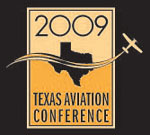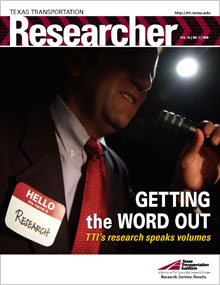2008 Texas Aviation Conference addresses economic realities

Some things you just take for granted. And some things you don’t even realize you had until they’re gone. Access to air travel, for example. Or even access to affordable goods flown to market by the air cargo industry.
The Texas Department of Transportation’s (TxDOT’s) 26th Annual Texas Aviation Conference brought aviators, airport managers and business interests from around the state to Austin, Texas, to discuss the current status of the industry. This year’s conference set records, with 567 aviation leaders in attendance and an unprecedented 70 exhibitors sponsoring the event.
“The 2008 conference was particularly important in light of all the things happening in transportation today,” observes Texas Transportation Institute (TTI) Associate Research Scientist Jeff Borowiec, who is conducting interagency agreement projects for TxDOT’s Aviation Division. “The conference brings together individuals with diverse interests and provides the opportunity to network and learn what others are doing throughout the state.”
Most people don’t realize just how important the aviation industry is to the Texas economy. A 2005 TxDOT study found that aviation is responsible for maintaining some 61,000 jobs and funding $2.5 billion in payroll. With 300 public general-aviation and 27 commercial-service airports in the Texas airport system, Texas is home to two of the top 10 busiest airports in the country, generating some $8.7 billion in economic output for the state. Texas’ gross state product ranks the second highest in the nation, and aviation contributes significantly not only to the state’s economy, but also to the nation’s financial well-being.
“Aviation is obviously a vital part of the Texas economy,” confirms Borowiec. “Given today’s economic realities, in some ways, it’s fighting for its very survival.”
This context framed the issues of concern at the conference. Participants discussed the economic impact of currently rising fuel costs and the collateral effects on shipping and consumer travel. According to one presentation, intrastate service in Texas appears particularly vulnerable to cutbacks. A large number of smaller, commercial-service airports in Texas are served by aging, turboprop aircraft, and the rising costs of doing business make serving these small communities more difficult.
Other presentations focused on the challenges of securing and holding onto federal funding, a primary source of financing projects at local airports. Three workshop sessions covered various aspects of the aviation industry, from airport security to wildlife management to risk management for municipal airports.
“Improving infrastructure, mitigating operational costs, ensuring safety—all these are central issues for the aviation industry, now more than ever,” says Dave Fulton, director of TxDOT’s Aviation Division. “This conference helps us synergize the way aviation works in Texas. Without it, we’d have a lot harder time working together to meet the needs of Texans.”
